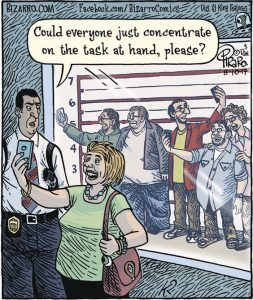Part II: Stop & Frisk, Arrest, Identification Procedures, Indictment
Last week in Part I: Search and Seizure, I asked (and mostly didn’t answer) the question of whether you should worry about getting the law right in your stories and novels. It’s up to you—after all, we’re writing fiction!
For the sake of realism, if you want your fictional perp to end up behind bars, this series of articles will give you a starting point for further thought and research. Check last week’s article for scenarios involving search warrants and exceptions to the warrant requirement. This week, I’ll pose some fictional crime scenes involving stop & frisk, arrest, identification procedures, and indictment.
Searches of the Person: Stop & Frisk; Incident to Arrest
 In criminal cases, the lawfulness of a stop or arrest typically arises on a motion to suppress the defendant’s statements or physical evidence. An improper arrest will not, on its own, give the court reason to dismiss the case, but if crucial evidence is suppressed, the prosecutor may be unable to proceed.
In criminal cases, the lawfulness of a stop or arrest typically arises on a motion to suppress the defendant’s statements or physical evidence. An improper arrest will not, on its own, give the court reason to dismiss the case, but if crucial evidence is suppressed, the prosecutor may be unable to proceed.
Whether criminally prosecuted or not, an unlawfully detained person may have a civil remedy. The most notable recent case like this was Floyd v City of New York, a civil rights class action filed on behalf of minority citizens challenging the NYPD stop and frisk program as racially discriminatory. Another notable case is Raymond v City of New York, a class action lawsuit filed by NYPD officers alleging an illegal arrest quota system. A plaintiff in Raymond was interviewed here on the MWA-NY blog. Notwithstanding these challenges to NYPD policies, a properly conducted stop and frisk (sometimes called a “Terry” stop after Terry v. Ohio, 392 U.S. 1 [1968]) remains a viable police tool.
The police may detain and question a person upon “reasonable suspicion” that criminal activity is afoot (something less than probable cause). Where there’s reasonable suspicion that the person is armed and dangerous, the police may also pat down the outer clothing and remove any items that feel like weapons. Full-blown probable cause permits an arrest and a more extensive search of the person and any closed containers in the area within the suspect’s immediate control (the “grab area”).
Crime Scene I:
Murderer, bleeding from the victim’s defensive scratches, goes to Walmart for bandages. His clothing conceals his injuries. As Murderer stands in line to pay, he’s sweating and acts nervous. Walmart’s Security Guard is watching him. After Murderer pays, Security Guard stops him, accuses him of shoplifting, frisks him, and finds the murder weapon, a knife.
Admissible: The Constitution protects individuals against government action—Security Guard is a private citizen. If a police officer had conducted this stop and frisk, it would be unlawful. Nervous or “furtive” movements, combined with other observations, may indicate a weapon, but there’s not enough here.
Note to writers of amateur sleuths (private citizens): The evidence your protagonist collects will usually be admissible in court! But beware. Your sleuth could be committing crimes like trespass and burglary by nosing around on private property without permission. Your sleuth could also be subject to civil lawsuit—but is your murderer going to be a very sympathetic plaintiff?
Crime Scene II:
On a summer night, Police Officers on motor patrol in a “high crime area” spot a young man walking. A silvery glint at the top edge of the man’s back pocket catches their eye. They pass him, stop the car, and get out. The man runs, they catch him. An Officer pats the back pocket, feels a hard object, and removes a cell phone that turns out to be stolen property.
Inadmissible: Not enough here for a reasonable suspicion that the man is armed and dangerous.
Crime Scene III-a:
During a buy and bust operation, Officers ghosting the UC arrest George after he sells glassines of heroin to the UC. An Officer searches George’s pockets, removes a zippered pouch, opens it, and finds several more glassines.
Admissible: On a search incident to arrest based on probable cause, officers may empty pockets and search closed containers without a warrant.
Crime Scene III-b:
Same as III-a except, instead of a zippered pouch, the stash is inside a small backpack that George left on the ground near his feet.
Admissible: Officers may search a closed container in the “grab area.”
 Crime Scene III-c:
Crime Scene III-c:
Same as III-a except the Officer finds a cell phone, which isn’t password protected. The Officer reads text messages about George’s other narcotics sales.
Inadmissible: Cell phones are not typical “containers” that can be searched without a warrant. An exception may apply in the case of “exigent circumstances” (e.g. imminent danger of physical harm to persons or destruction of evidence).
Arrest Inside the Home
Your home is your castle. The police can’t enter a home to arrest a suspect without a warrant. A few exceptions: consent (a person with authority voluntarily lets the police in); exigent circumstances (e.g. a reasonable belief that the suspect is harming someone in the home); hot pursuit (a suspect being chased cannot avoid arrest by running inside).
Crime Scene IV:
Police Officers have probable cause to arrest Murderer. They go to Murderer’s home without an arrest warrant, knock on the door, and move away from the peephole. Murderer cautiously opens the front door and sticks his head out to look around. The Officers pull him outside, place him under arrest, and he spontaneously makes incriminating statements.
Inadmissible: Some cases have allowed arrests in a doorway, reasoning that the suspect voluntarily came into “public view.” An arrest is usually no good if the suspect is partially outside or tricked into coming outside. New York draws a bright line at the threshold. Better get an arrest warrant unless there’s an emergency.
Identification Procedures
The unreliability of eyewitness identification is the subject of much study and debate in this era of DNA exoneration. Police arranged show ups and lineups are inherently suggestive because the witness might assume that the police have caught the culprit. In court, these identification procedures are inadmissible if they were conducted in an “unduly suggestive” manner. A positive ID from a show up or lineup can be crucial to the People’s case where the sole eyewitness can no longer identify the defendant at trial.
 Crime Scene V:
Crime Scene V:
Victim gives Detective a full description of her assailant, who has a three-inch scar on his forehead. Detective catches a Suspect fitting the description and arranges a lineup. The five fillers have the same approximate height, weight, hair color, and skin tone, but Detective couldn’t find any fillers with scars. Victim picks Suspect.
Likely inadmissible: Generally, a lineup will be suppressed as unduly suggestive if the defendant is the only person with a unique characteristic.
Crime Scene VI-a:
Responding to a radio report, Police Officers stop Suspect, who fits the description of an armed robber. The crime occurred ten minutes ago, three blocks away. Unbeknownst to the Officers, Victim has been following Suspect and sees the Officers frisking him. Victim walks up and spontaneously yells, “That’s him!”
Admissible: This is not a police-arranged show up, so the purpose of the exclusionary rule—to deter police misconduct—is not present.
Crime Scene VI-b:
Same as VI-a, but the Victim stays at the crime scene. The Officers handcuff Suspect, put him in the back seat of the squad car, and drive three blocks to the Victim, who looks inside the car and identifies him.
Gray area: Cases like this go both ways. A court could find the indicia of police custody unduly suggestive. Cases which uphold similar show ups emphasize the interests in reliability and avoiding mistakes. A positive ID at this point is made when Victim’s memory is freshest. Alternatively, if Victim can’t make the ID, an innocent person can be released.
Let’s Make—No, Let’s Indict—A Ham Sandwich
 In New York and other states, a felony prosecution is usually commenced by indictment of the grand jury, a body of 23 citizens. The prosecutor instructs the grand jury on the law and must present legally sufficient evidence of the offense. A person can be indicted before or after arrest. In most cases, the defendant is being held in jail on a felony complaint prior to indictment. In New York, the defendant is released without bail if the prosecutor fails to get an indictment within 120 hours (or 144 when a weekend or holiday intervenes). The defendant has the right to testify and to have the advice of an attorney while testifying. Defense attorneys are not allowed to question witnesses or address the jury.
In New York and other states, a felony prosecution is usually commenced by indictment of the grand jury, a body of 23 citizens. The prosecutor instructs the grand jury on the law and must present legally sufficient evidence of the offense. A person can be indicted before or after arrest. In most cases, the defendant is being held in jail on a felony complaint prior to indictment. In New York, the defendant is released without bail if the prosecutor fails to get an indictment within 120 hours (or 144 when a weekend or holiday intervenes). The defendant has the right to testify and to have the advice of an attorney while testifying. Defense attorneys are not allowed to question witnesses or address the jury.
In my novel Forsaken Oath, I had fun with the time limit. It was hour 142. My fictional murder suspect testified in the grand jury and surprised the prosecutor with an unlikely defense. A dilemma was presented. Should the case be put to a vote, risking dismissal, or should the suspect be released, to allow investigation of the defense? The latter course eventually paid off.
Due to the high volume of cases, a day in the grand jury can seem like an assembly line. The prosecutor is the de facto “judge” and keeps the evidence to the legal minimum. This reality accounts for the famous saying that the prosecutor could indict a “ham sandwich.” Former Chief Judge Sol Wachtler, who was on the bench during the years I argued in New York’s highest court, is credited with this remark—although here’s an interesting article debating the source.
Authors: Here are a couple of other aspects about the grand jury that may spur your creativity:
Grand jury proceedings are secret, to protect witnesses and to avoid tipping off targets. Leaks and the consequences make for interesting plot twists. Or perhaps you want to depict public outrage when the grand jury exonerates a suspect. A notable case like this is Matter of James v Donovan, which denied a public demand for disclosure of the proceedings of the grand jury investigating the death of Eric Garner during his arrest on Staten Island.
Also, witnesses in the grand jury have immunity from prosecution for any crimes they reveal in their testimony. In New York, this is automatic “transactional immunity,” the broadest sort, not mere “use immunity.” Defendants exercising their right to testify must sign a waiver of immunity.
Crime Scene VII-a:
The target of a grand jury investigation is Big Fish, the mastermind of a lucrative money laundering operation. Little Fish is testifying. The prosecutor, knowing that the Big and Little Fishes discussed the operation on a certain date, foolishly asks an open-ended question about what happened on that date. Little Fish answers, “I shot and killed Medium Fish, then I had a meeting with Big Fish.”
Witness Has Immunity: Witness’s testimony was responsive to a question. Prosecutors, take care! Otherwise, get a waiver of immunity from the witness.
Crime Scene VII-b: Same as VII-a, except that, before the prosecutor asks anything, Little Fish blurts out: “I killed Medium Fish!”
No Immunity: The answer must be responsive to questioning to get immunity.
Links
I’ll repeat here the links I gave last week to start your research: Nolo, Justia, and FindLaw Legal Dictionary.
For further reading on the issue of eyewitness identification, see this Report of The National Center for State Courts, and recommendations of The Innocence Project. Click here for an article on doorway arrests. And here’s a great summary of grand jury procedure by the New York County Lawyers Association.
See you next week for Guilty Pleas and Trials!
___________________________

V.S. Kemanis is the author of four legal suspense novels featuring prosecutor Dana Hargrove. In her career as a lawyer, she has worked for the Manhattan District Attorney, the NYS Organized Crime Task Force, the Appellate Division of New York Supreme Court, and appellate judges in New York and Colorado.

Hi V. S.,
I find your blogs very interesting. My older son is a criminal defense attorney here in NJ. Several of my stories featuring an attorney have been published in Sherlock Holmes Mystery Magazine. U. S. law is never dull!
Thank you, Jacqueline. Great that you have an expert in the family for your criminal law questions!